If you want to master the art of shooting you will also need good precision and be able to decide when to fire a well placed shoot. This will be the key points for how many goals you will score. Good scoring ability is also important because it may increase your chances of becoming professional. But don't get me wrong, just because you are good at scoring doesn't mean that you will become professional!
Instead, you must work hard to improve your weak sides, because no soccer player in the world is perfect, and I don't think he/she will ever exist. Now, let's check out the different soccer shooting methods...
Instep Drive or The Knuckle Shot
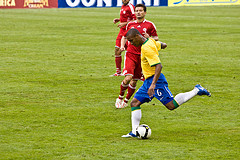 The instep drive is a very useful soccer shooting technique when you want to strike the ball with power from long range. However, this type of shot is very hard to control which means that you should not be surprised if the ball ends up 20-30 yards behind the goal.
The instep drive is a very useful soccer shooting technique when you want to strike the ball with power from long range. However, this type of shot is very hard to control which means that you should not be surprised if the ball ends up 20-30 yards behind the goal. Swerve Shot
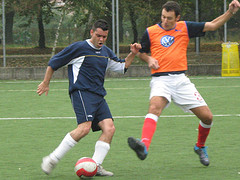 A goalkeeper's worst nightmare is known as the swerve shot.
This type of shot will swerve once you fire it and to save it requires a
lot of effort. However, learning learn how to perform a swerving shot
is really difficult and not many players in the world are able to
perform it in high tempo. However, you should still practice on it and
try it out in real games because failure is the key to success.
A goalkeeper's worst nightmare is known as the swerve shot.
This type of shot will swerve once you fire it and to save it requires a
lot of effort. However, learning learn how to perform a swerving shot
is really difficult and not many players in the world are able to
perform it in high tempo. However, you should still practice on it and
try it out in real games because failure is the key to success.Full Volley
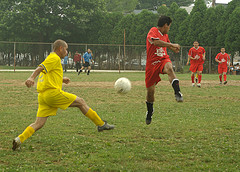 A full volley
can create a powerful shoot which can be impossible to save (if you get
it on the goal of course). The most difficult thing with a full volley
is to get your shot on the goal). You really need to hit the ball
perfectly and in right moment. If you fail to do so, the ball will often
end 20 yards behind the goal. This type of shot is ideal when you have
several opponents running towards you while the ball is falling from the
sky. A common situation is when the ball is cleared away from a corner
kick and you are standing about 5-10 yards from the penalty box line.
A full volley
can create a powerful shoot which can be impossible to save (if you get
it on the goal of course). The most difficult thing with a full volley
is to get your shot on the goal). You really need to hit the ball
perfectly and in right moment. If you fail to do so, the ball will often
end 20 yards behind the goal. This type of shot is ideal when you have
several opponents running towards you while the ball is falling from the
sky. A common situation is when the ball is cleared away from a corner
kick and you are standing about 5-10 yards from the penalty box line. Half Volley
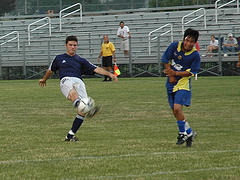 A half volley
is pretty similar to the full volley except that you will first get
control on the ball and then fire the shot. This is also why a half
volley is a better alternative for long range shoots because you will be
able to receive, aim and fire the shot while the opponents are
unprepared. However, keep in mind that beating the keeper with a 30 yard
shoot really requires a lot of skill. But, I've seen people score goals from 70 yard with the half volley so it is not impossible. Like with any other soccer shot you should not overdo it. Instead, try it twice but not more than three times per game.
A half volley
is pretty similar to the full volley except that you will first get
control on the ball and then fire the shot. This is also why a half
volley is a better alternative for long range shoots because you will be
able to receive, aim and fire the shot while the opponents are
unprepared. However, keep in mind that beating the keeper with a 30 yard
shoot really requires a lot of skill. But, I've seen people score goals from 70 yard with the half volley so it is not impossible. Like with any other soccer shot you should not overdo it. Instead, try it twice but not more than three times per game.Side Volley
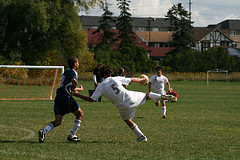 A side volley
is great when you have the ball bouncing at your side. A side volley
requires good balance and great precise timing which means that you need
to play it properly before striking the ball.
The most difficult thing with a side volley is to get the ball on the
goal. It may look easy but often you will either totally miss the ball
or send it 30 yards behind your opponent's goal.
A side volley
is great when you have the ball bouncing at your side. A side volley
requires good balance and great precise timing which means that you need
to play it properly before striking the ball.
The most difficult thing with a side volley is to get the ball on the
goal. It may look easy but often you will either totally miss the ball
or send it 30 yards behind your opponent's goal. Flying Volley
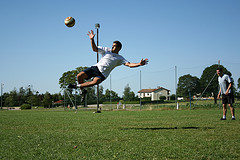 The flying volley is not something you will see every day. This is a type of shoot
that requires great acrobatic abilities and timing. The most difficult
thing with a flying volley is that you need to jump in the right moment.
It is also crucial to know how to land because if the ground is hard it
will hurt, believe me; I know what I am talking about :-) There is also
a risk that you could hit your opponents head instead of the ball. So,
be cautious and make sure to plan your jumps.
The flying volley is not something you will see every day. This is a type of shoot
that requires great acrobatic abilities and timing. The most difficult
thing with a flying volley is that you need to jump in the right moment.
It is also crucial to know how to land because if the ground is hard it
will hurt, believe me; I know what I am talking about :-) There is also
a risk that you could hit your opponents head instead of the ball. So,
be cautious and make sure to plan your jumps.
 The
The  When performing a
When performing a  When performing a
When performing a  When performing a
When performing a